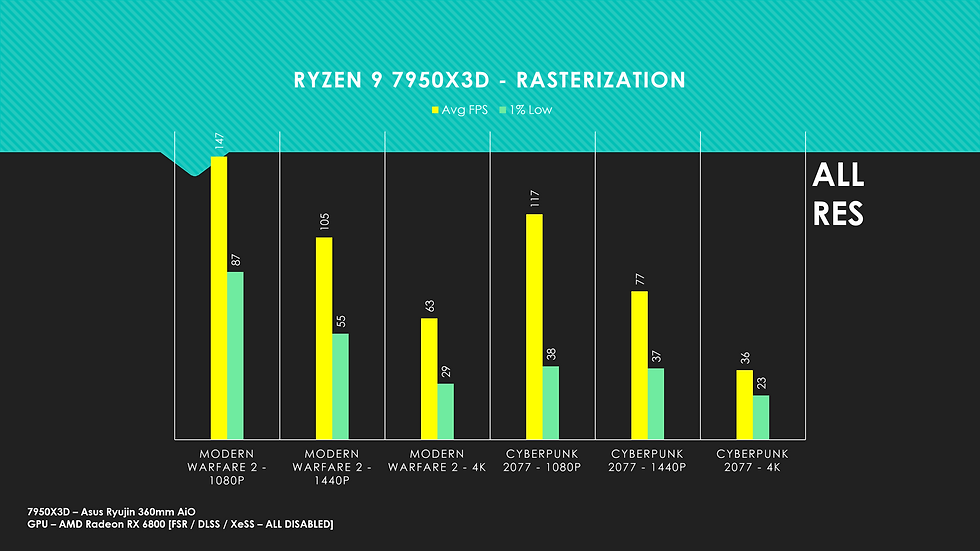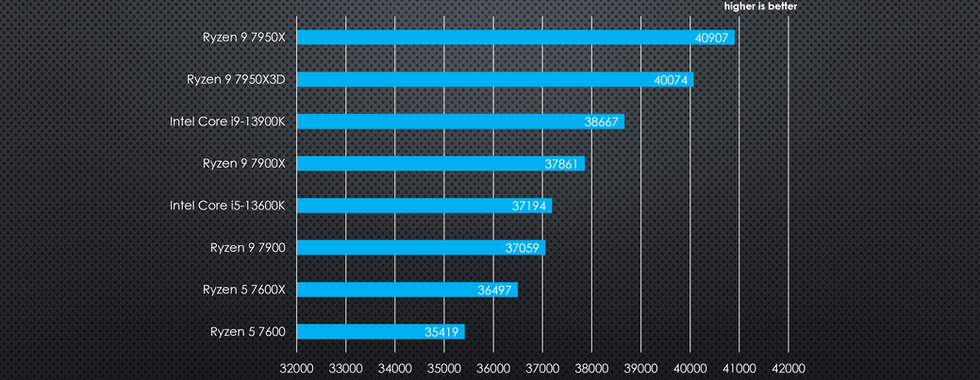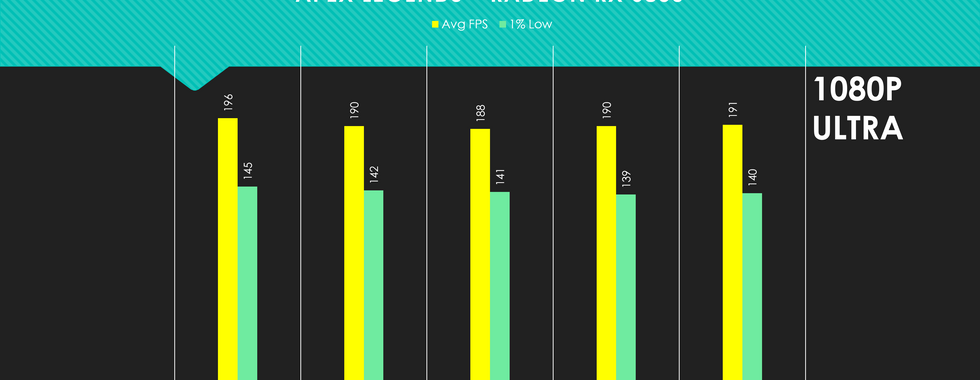AMD Ryzen 9 7950X3D Review: A Tough Sell.
- Soon Kai Hong
- Feb 27, 2023
- 5 min read
This is the AMD Ryzen 9 7950X3D and it is the fastest gaming CPU right now. Or so we would like to say with confidence but the whole story isn’t exactly true. While it might actually be the fastest gaming CPU right now, it does so at a price of US$699. To top that off, it isn’t exactly that much faster either. We’re talking just single digit percentages at best. The upside however? It certainly is efficient unlike any other. But should you buy one? For the first time with AMD, we’re actually going to say, probably not. Not now anyways.
For a start, we’re pretty sure that most people would be comparing the Ryzen 9 7950X3D with its non-3D counterpart, the Ryzen 9 7950X. Just to refresh your memory, both the Ryzen 9 7950X3D and Ryzen 9 7950X will retail for US$699 while the competition, the Intel Core i9-13900K retails for US$589. But it is to be noted that you can pretty much get the 7950X and 13900K for quite a bit less nowadays.
The Difference
So here comes the 7950X3D at US$699. What difference is there?

It boils down to three main things. 3D V-Cache itself, double the L3 cache for 144MB of total cache and power efficiency of just a 120W TDP.
Off To The Test!
That’s pretty much it. All else is pretty much the same as the non-3D version. So without further ado, let’s just jump straight into it. As of this review, these are the specifications of the rig that we’re testing with and these are the drivers that were used for both Ryzen and Radeon during testing.
First up, we have Cinebench R23 as usual and as you can tell, the Ryzen 9 7950X3D basically sits right below the Ryzen 9 7950X and it is also worth noting that it does sit right in between the Ryzen 9 7900X as well as the Core i9-13900K.
With Blender, we tested the usual BMW scene as well as the Classroom scene and the results are pretty much the same as with Cinebench. The X3D chip sits just below the non-X3D variant and is pretty much on par with that of the 13900K.
We then have FireStrike and just like before, we advise to take out results with a slight grain of salt as we simply do not have access to the latest and greatest everytime we want. However, we’ve managed to keep at least the parameters pretty much exactly the same as before with the Radeon RX 6800. But surprise or perhaps of no surprise, the 7950X3D basically performed equally as good as the non-X3D variant. Which also means it is still a little ahead of Team Blue as well.
Okay so at this point, it is pretty clear that the Ryzen 9 7950X3D was never intended to be great at creative workloads. If you’re more of a content creator, the standard Ryzen 9 7950X is still the way to go. The main reason you would want to look at the X3D variant is simply because of gaming. So let’s talk about gaming.
Due to hardware and inventory changes in the past few months, we weren’t able to test a whole suite of games but at the very least, we managed to run a few games that we already have data on with other chips. So let’s first talk about those.
We start with CS:GO at 1080P. With the Radeon RX 6800, the 7950X3D manages to push just above 700 frames per second on average, giving a healthy 5% increase over the 7900X and the 7900 that we tested before. Moving the resolution up to 1440P and we see pretty much the same percentage increase. The same can also be said when we’re running full native 4K.
As for Apex Legends, the difference is much less. No matter the resolution, be it at 1080P, 1440P or even full 4K, the 7950X3D performed just about 2% better across the board for both the average frame rate as well the 1% low.
We then come to Shadow of the Tomb Raider and here, the performance is just similar across the board, across all three resolutions. The only big difference would be the fact that the 1% low at 1080P is quite a lot better with the X3D as compared to the non-X3D.
Honestly though, we would say that part of the fact that the difference seems negligible and not akin to those shared by AMD themselves is simply because we do not have the latest and greatest GPU. In addition, the drivers we used were provided by AMD themselves and aren’t released to the public as of yet. There might be some hiccups here and there.
Now we also tested the latest Modern Warfare 2 as well as Cyberpunk 2077. As we are unable to replicate the testing scenario with the other chips and more, we’ll simply leave the data here so that you, as the viewer, will be able to make cross references should you need to.

Just a mention, all the frame rates shown are without the use of upscaling technologies such as FSR or DLSS. Do take note.
Temperature & Efficiency
Lastly, we talk about temperatures.
One interesting thing to note is that the TJMax for the Ryzen 9 7950X3D is actually just 89°, which is 6° lower than the Ryzen 9 7950X. So we do highly suggest investing in a really good air-cooled tower or go with a 240mm or 360mm AiO. As mentioned, we do have ours hooked up to a 360mm AiO and during full on CPU intensive workloads such as Cinebench, you’ll find that it can run up to 82° quite frequently. Though it does push about 5.45GHz on all cores while doing that, which is pretty impressive. Temperatures during gaming are even lower, so no worries there at all.
But the most impressive thing is the power efficiency. The 7950X3D was able to dish out that much performance while just drawing about 130 watts or so. Compared to the 7950X, that’s way lower. Compared to the 13900K, I think we needn’t even bother. Kudos to AMD for this, seriously.

So all in all, where does this place the Ryzen 9 7950X3D?
Get The Ryzen 7 7800X3D Instead
To be very honest, we don’t really know. As of right now, with a launch price of US$699, the Ryzen 9 7950X3D is simply in a really tough spot. On one hand, the Ryzen 9 7950X can be had for much less nowadays and that’ll not only perform better with creative work loads, the gaming performance is still pretty much equally as good in most titles. And if you’re looking at Team Blue, the Core i9-13900K retails for US$589 at launch and be had for even less nowadays and that pretty much performs on par with the Ryzen 9 7950X3D while also being a really capable chip for creative work as well, just like with the Ryzen 9 7950X.
On the same topic, the Ryzen 9 7900X3D and the Ryzen 7 7800X3D are also available. And if you’re just solely looking for the utmost in gaming performance, these two chips aren’t no slouch either.
If you’re looking for the utmost for gaming and for the best bang for your buck, the Ryzen 7 7800X3D would probably be the chip to go for. On the other hand, if you really require all that extra cores to work with your creative assets, the standard Ryzen 9 7950X would probably be the better choice. And thus we can only really say that the Ryzen 9 7950X3D might just be a tough sell.
In any case, we hope that we were able to provide a little bit of insight and yes, we understand that our testing and benchmarking practices aren’t the most complete as compared to most other established reviewers. But we promise to do much more in the future and grow this segment.




































